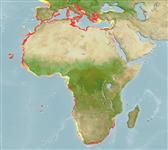>
Eupercaria/misc (Various families in series Eupercaria) >
Sparidae (Porgies)
Etymology: Lithognathus: Greek, lithos = stone + Greek, gnathos = jaw (Ref. 45335).
More on author: Linnaeus.
Environment: milieu / climate zone / rango de profundidad / distribution range
Ecología
marino; salobre demersal; rango de profundidad 0 - 150 m (Ref. 3688), usually 10 - 20 m (Ref. 37413). Subtropical; 48°N - 35°S, 25°W - 36°E
Eastern Atlantic: Bay of Biscay, Strait of Gibraltar, Mediterranean, and Black Sea (Ref. 4781, 112870), Madeira Is (Ref. 74541), Canary Is. and Cape Verde Islands (Ref. 3688), southward to Cape of Good Hope, South Africa. Western Indian Ocean: southern Mozambique (Ref. 3688); Red Sea (Ref. 84159). Not found in tropical east Africa (Ref. 3198),
Length at first maturity / Tamaño / Peso / Age
Madurez: Lm 17.4, range 20 - ? cm
Max length : 55.0 cm TL macho / no sexado; (Ref. 3397); common length : 30.0 cm TL macho / no sexado; (Ref. 3688); edad máxima reportada: 12 años (Ref. 13716)
Short description
Claves de identificación | Morfología | Morfometría
Espinas dorsales (total) : 11; Radios blandos dorsales (total) : 12 - 13; Espinas anales: 3; Radios blandos anales: 10 - 11.
Body shape (shape guide): fusiform / normal.
Found on the shelf, over sandy and muddy bottoms as well as seagrass-beds and estuaries. Gregarious, sometimes forming sizeable schools. Feeds on worms, mollusks and small crustaceans. Protandric hermaphrodite (Ref. 3688). Flesh excellent (Ref. 3198); sold fresh and dried.
A monandric species (Ref. 55367). In the northern Adriatic, overall male to female ratio was 1:1.62. Sex inversion occurred mainly between 24.1 and 35.2 cm TL and 3.5 years of age (Ref. 55367). Conflicting descriptions of the reproductive style of this species have been reported, including possible gonochorism (Ref. 103751). Also Ref. 28504.
Bauchot, M.-L. and J.-C. Hureau, 1990. Sparidae. p. 790-812. In J.C. Quero, J.C. Hureau, C. Karrer, A. Post and L. Saldanha (eds.) Check-list of the fishes of the eastern tropical Atlantic (CLOFETA). JNICT, Lisbon; SEI, Paris; and UNESCO, Paris. Vol. 2. (Ref. 3688)
IUCN Red List Status (Ref. 130435: Version 2025-1)
Threat to humans
Harmless
Human uses
Pesquerías: escaso valor comercial; pesca deportiva: si
Herramientas
Special reports
Download XML
Fuentes de Internet
Estimates based on models
Preferred temperature (Referencia
123201): 17.1 - 27.5, mean 24.4 °C (based on 224 cells).
Phylogenetic diversity index (Referencia
82804): PD
50 = 0.5625 [Uniqueness, from 0.5 = low to 2.0 = high].
Bayesian length-weight: a=0.01202 (0.01075 - 0.01344), b=3.02 (2.99 - 3.05), in cm total length, based on LWR estimates for this species (Ref.
93245).
Nivel trófico (Referencia
69278): 3.5 ±0.39 se; based on food items.
Generation time: 4.8 (4.0 - 5.6) years. Estimated as median ln(3)/K based on 12
growth studies.
Resiliencia (Referencia
120179): Medio, población duplicada en un tiempo mínimo de 1.4-4.4 años (K=0.24; tm=2).
Prior r = 0.54, 95% CL = 0.36 - 0.81, Based on 1 full stock assessment.
Fishing Vulnerability (Ref.
59153): Moderate vulnerability (40 of 100).
🛈
Climate Vulnerability (Ref.
125649): Low to moderate vulnerability (31 of 100).
🛈
Nutrients (Ref.
124155): Calcium = 72.3 [42.6, 133.6] mg/100g; Iron = 1.06 [0.62, 1.89] mg/100g; Protein = 19 [18, 21] %; Omega3 = 0.417 [0.289, 0.641] g/100g; Selenium = 28.2 [14.1, 49.5] μg/100g; VitaminA = 9.68 [3.47, 23.67] μg/100g; Zinc = 0.831 [0.601, 1.145] mg/100g (wet weight); based on
nutrient studies.
